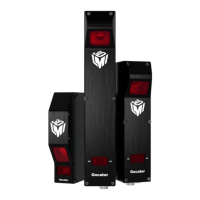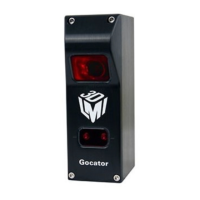Gocator Line Profile Sensors: User Manual
Gocator Web Interface • 320
Name Description
Laplacian Applies a Laplacian filter.Useful for detecting areas of distinct edges. Uses the following
kernel:
Negative Inverts the height values in the scan data.
Equalize Normalizes the norm or value range of an array.
Binarize Sets height values to a fixed value for each point that is present in the data. Can be used
with a region Z offset to threshold points above/below a Z value.
Percentile Limits the scan data to points between the values you set in High Percentile and Low
Percentile, which are displayed when you choose this option.
Relative Height Crops scan data based on user-specified minimum and a maximum heights. Use Reference
Region to set the heights relative to a reference region.
Crop only Crops the scan data to the user-defined region.
Mask With Input Uses the surface input into the tool as a mask on the data. Any points in the filtered data
will be set to null if the input surface is null at the same location.
For example, the Gaussian filter can extend data along the edges, adding data in areas that
contain null values. This filter would remove data that the Gaussian filter introduces,
preserving the null values.
This filter should follow any filter that introduces this kind of unwanted data.
Type Description
Filtered Surface
The filtered data, available for use as input in the Stream
drop-down in other tools.
Data
Anchor Description
X, Y, or Z Lets you choose the X, Y, or Z measurement of another tool
to use as a positional anchor for this tool.
Anchoring
A measurement must be enabled in the other tool for it to be available as an anchor. The anchor
measurement should also be properly configured before using it as an anchor.
For more information on anchoring, see Measurement Anchoring on page 211.

